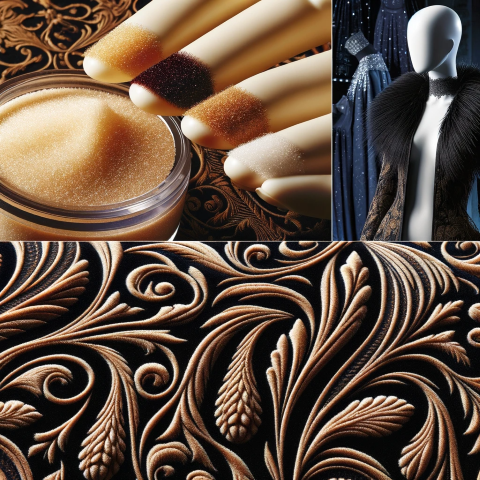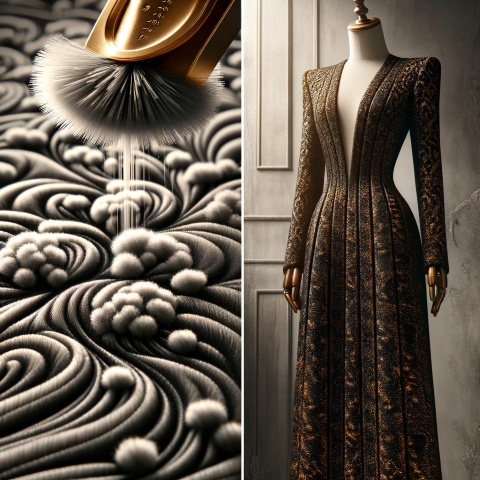What is "Flocking" - Definition & Explanation
Last Updated on: 28-Feb-2023 (1 year, 1 month, 25 days ago)
Share on Facebook • Share on Twitter
Last Updated on: 28-Feb-2023 (1 year, 1 month, 25 days ago)
Share on Facebook • Share on Twitter
Flocking
Flocking is a decorative textile finishing process that involves applying small fibers, called flock, to a surface to create a soft, velvet-like texture. Flocking can be applied to a wide range of fabrics, including clothing, upholstery, and home decor items, and is used to create a variety of decorative effects, such as patterns, designs, and logos.
The flocking process involves several steps. First, a pattern or design is created on the surface of the fabric using an adhesive. The adhesive is then dried, and small fibers of flock material are applied to the surface of the fabric using an electrostatic charge. The fibers are attracted to the adhesive, and stick to the surface of the fabric, creating a soft, textured finish.
Flock material is typically made from synthetic or natural fibers, such as polyester, nylon, or rayon. The fibers can be cut to different lengths and colors, depending on the desired effect. Shorter fibers are used to create a more dense, velvety texture, while longer fibers are used to create a more shaggy, tufted texture.
Flocking can be applied to a wide range of surfaces, including fabrics, paper, plastic, and metal. It is used in a variety of industries, including fashion, automotive, and home decor. In the fashion industry, flocking is used to create a variety of effects, including animal prints, polka dots, and stripes. It is also used to create logos and branding on clothing and accessories.
One of the key advantages of flocking is its versatility. Because flocking can be applied to a wide range of surfaces, it can be used to create a variety of decorative effects, from subtle and understated to bold and dramatic. Flocking can also be used to add texture and dimension to a design, making it an ideal choice for creating unique and eye-catching patterns.
Another advantage of flocking is its durability. Flocked surfaces are resistant to wear and tear, and are less likely to fade or fray over time. This makes flocking an ideal choice for items that are subjected to heavy use, such as upholstery and clothing.
Flocking is also an eco-friendly process, as it can be done using non-toxic, water-based adhesives and recycled fibers. This makes it a sustainable choice for textile finishing and decoration.
In conclusion, flocking is a decorative textile finishing process that involves applying small fibers to a surface to create a soft, velvet-like texture. It is used to create a wide range of decorative effects, from subtle and understated to bold and dramatic. Flocking is a versatile, durable, and eco-friendly process that is used in a variety of industries, including fashion, automotive, and home decor.
The flocking process involves several steps. First, a pattern or design is created on the surface of the fabric using an adhesive. The adhesive is then dried, and small fibers of flock material are applied to the surface of the fabric using an electrostatic charge. The fibers are attracted to the adhesive, and stick to the surface of the fabric, creating a soft, textured finish.
Flock material is typically made from synthetic or natural fibers, such as polyester, nylon, or rayon. The fibers can be cut to different lengths and colors, depending on the desired effect. Shorter fibers are used to create a more dense, velvety texture, while longer fibers are used to create a more shaggy, tufted texture.
Flocking can be applied to a wide range of surfaces, including fabrics, paper, plastic, and metal. It is used in a variety of industries, including fashion, automotive, and home decor. In the fashion industry, flocking is used to create a variety of effects, including animal prints, polka dots, and stripes. It is also used to create logos and branding on clothing and accessories.
One of the key advantages of flocking is its versatility. Because flocking can be applied to a wide range of surfaces, it can be used to create a variety of decorative effects, from subtle and understated to bold and dramatic. Flocking can also be used to add texture and dimension to a design, making it an ideal choice for creating unique and eye-catching patterns.
Another advantage of flocking is its durability. Flocked surfaces are resistant to wear and tear, and are less likely to fade or fray over time. This makes flocking an ideal choice for items that are subjected to heavy use, such as upholstery and clothing.
Flocking is also an eco-friendly process, as it can be done using non-toxic, water-based adhesives and recycled fibers. This makes it a sustainable choice for textile finishing and decoration.
In conclusion, flocking is a decorative textile finishing process that involves applying small fibers to a surface to create a soft, velvet-like texture. It is used to create a wide range of decorative effects, from subtle and understated to bold and dramatic. Flocking is a versatile, durable, and eco-friendly process that is used in a variety of industries, including fashion, automotive, and home decor.
Flocking
A process in which short chopped lengths of fibre (flock) are applied to an adhesive coated backing fabric or other substrate. The application is usually carried out electrostatically.
A process in which short chopped lengths of fibre (flock) are applied to an adhesive coated backing fabric or other substrate. The application is usually carried out electrostatically.
Flocking
�A type of raised decoration applied to the surface of a fabric in which an adhesive is printed on the fabric in a specific pattern, and then finely chopped fibers are applied by means of dusting, air-brushing, or electrostatic charges. The fibers adhere only to the areas where the adhesive has been applied, and the excess fibers are removed by mechanical means.
�A type of raised decoration applied to the surface of a fabric in which an adhesive is printed on the fabric in a specific pattern, and then finely chopped fibers are applied by means of dusting, air-brushing, or electrostatic charges. The fibers adhere only to the areas where the adhesive has been applied, and the excess fibers are removed by mechanical means.
Flocking
�Decoration made from very short velvety fiber
�Decoration made from very short velvety fiber
Some other terms
Some more terms:
Heald Shaft
54
A frame in which a large number of healds are mounted. Typically a loom contains two or more heald shafts, depending upon the complexity of the weave pattern required. The heald shaft is raised or...
Nap
45
Shaded or directional design that requires all parts of the garment to be cut in the same direction. May result from the print or weave of the fabric or the way the fabric is made. Velvet,...
Tassel Trim
836
Tassel trim is a decorative element used in textiles that adds flair, elegance, and a touch of personality to various fabric-based products. It consists of a series of hanging threads or cords, often...
Sustainable clothing and sustainable fashion is very subjective. Clothing that reduces the environmental impact. Clothing that supports and nourishes the earth and the lives of all people involved in...
Greige
465
Greige (pronounced "gray") is a term used in the textile industry to describe fabric that has not yet been finished or processed. Greige fabric is also referred to as "gray goods" or "loom-state...
Add a definition
Add a definition for a textile term that you know about! Send us an email & tell us:
- The term you want to define
- Its definition in 500 words or less
- Attach an image if necessary.
- Optionally, tell us about yourself in 200 words or less!
Companies for Flocking:
If you manufacture, distribute or otherwise deal in Flocking, please fill your company details below so that we can list your company for FREE! Send us the following details:
- Company name
- Company address
- Attach a logo, if necessary.
- Optionally, tell us about yourself in 200 words or less!
(s) 2024 TextileGlossary.com Some rights reserved. • Sitemap

